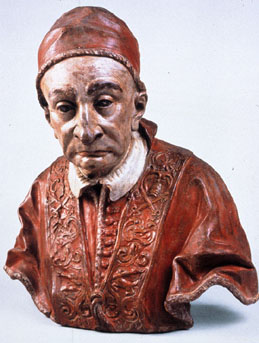 If Pietro Francesco Orsini was born with a silver spoon in his mouth, he did not wait long to throw it away. Born February 22, 1649, at Gravina, Pietro Francesco was the heir not only to his father, the duke of Gravina, but to his uncle, the duke of Bracciano. But the noble young man spurned these great Orsini titles for the white habit of a son of St. Dominic. Though he overcame family opposition to become a Dominican friar, it was difficult in that aristocratic age for a highborn ecclesiastic to escape honors. Clement X forced the red hat on the reluctant young friar, and soon he was ruling the see of Manfredonia, then Cesena, and finally Benevento, where he spent thirty-eight years. He loved Benevento and earned the title of the city's second founder by his loving charity after the disastrous earthquakes of 1688 and 1702.
If Pietro Francesco Orsini was born with a silver spoon in his mouth, he did not wait long to throw it away. Born February 22, 1649, at Gravina, Pietro Francesco was the heir not only to his father, the duke of Gravina, but to his uncle, the duke of Bracciano. But the noble young man spurned these great Orsini titles for the white habit of a son of St. Dominic. Though he overcame family opposition to become a Dominican friar, it was difficult in that aristocratic age for a highborn ecclesiastic to escape honors. Clement X forced the red hat on the reluctant young friar, and soon he was ruling the see of Manfredonia, then Cesena, and finally Benevento, where he spent thirty-eight years. He loved Benevento and earned the title of the city's second founder by his loving charity after the disastrous earthquakes of 1688 and 1702.
When the conclave of 1724 was worn out with over two months of ineffectual wrangling, the cardinals turned to the spiritual-minded Dominican archbishop. But Orsini refused, and it took a great deal of argument and the pressure of the Dominican general to bring him to accept. He chose to be called Benedict XIII.
One of the first problems faced by Benedict was the accusation against the Jesuits of insubordination in the matter of the Chinese rites. Benedict, after mature consideration, convinced by Jesuit General Tamburini's defense, acquitted the Jesuits and quashed the stern decree of Innocent XIII.
The Jansenists, disappointed in Innocent XIII, had great hopes in Benedict. These sectaries tried to shelter themselves behind the massive form of St. Thomas and claimed that they held Dominican doctrine on grace. The Dominican Pope disabused them. He issued a bull filled with praise of St. Thomas and of the Dominicans, but of words of encouragement for Jansenists there were none. Benedict insisted on submission to Clement XI's bull Unigenitus, and what is more, he secured the submission of the Jansenist's champion, Cardinal de Noailles, archbishop of Paris. At long last it was the beginning of the end for Jansenism.
Benedict was less happy in his dealings with the Powers. The shrewd politicos of the despots' courts wrung extreme concessions from the good- natured and inexperienced Pontiff. Even less happy was Benedict in routine government. Though he tried hard to improve ecclesiastical discipline and was most devoted to the spiritual side of his work, he was too loyal to his friends. He placed implicit confidence in a cleric he had brought from Benevento, Cardinal Coscia. Coscia was a grafter, and under him the papal curia deteriorated. Benedict, busy insisting that priests should not wear wigs and blessing altars, was deaf to the clink of gold talking loudly to Coscia and his associates.
Benedict XIII died February 23, 1730. His virtues were his own, his defects were due to inexperience and lack of aptitude for government. After all, he had not wanted to be pope. Benedict left the Church a legacy most precious. He first approved of the Congregation of the Cross and Passion of Our Lord founded by St. Paul of the Cross.
Excerpted from "Popes
Through the Ages" by Joseph Brusher, S.J.

